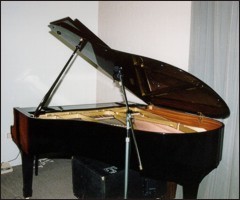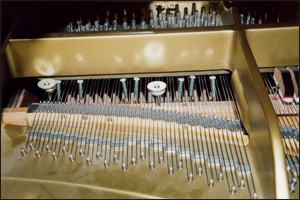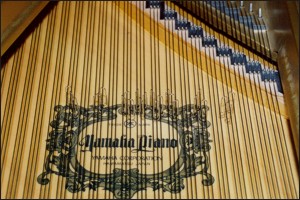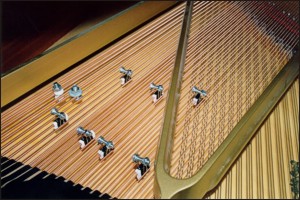Performance Events
Performance at the Second Annual Delta State University Electroacoustic Juke Joint, November 13-15, 2008
Bologna Performing Arts Center, Delta State University, Cleveland, Mississippi, USA
Broadcast on Electrain de nuit – Radio France, Paris, France
Thursday, 22 May, 2008
Alexandre Bazin (Presenter)
Broadcast on Foldover – WOBC 91.5 FM, Oberlin, Ohio, USA
Wednesday, 19 March, 2008
Tom Lopez (Assistant Professor, Computer Music and Digital Arts, Oberlin Conservatory of Music, Oberlin, Ohio, USA)
Performance at ‘Free Play 10: Listening Chamber / Electro-acoustic Music from Around the World’
Thursday, February 21, 2008, GVSU Art Gallery, Grand Valley State University, Allendale, Michigan, USA
Performance at the Melbourne International Arts Festival
John Cage’s Musicircus
Friday, 26 October, 2007
BMW Edge, Federation Square, Melbourne, Australia
Performance by the Chicago Composers Forum
John Cage’s Musicircus 2007
Sunday, 7 October, 2007, Chicago Cultural Centre, Chicago, Illinois, USA
Broadcast on Radio Beethoven (Radioemisoras) ‘Siglo XX’ – 96.5 FM, Santiago, Chile
Wednesday, 12 July, 2006
José Oplustil Acevedo (Presenter)
Performance at the V Festival Internacional de Música Electroacústica de Santiago – Ai-maako 2005
(5th International Festival of Electroacoustic Music of Santiago), 17-22 October, 2005, Santiago, Chile
Concierto Internacional D (International Concert D)
Saturday, 22 October, 2005, Centro Cultural de España, Santiago, Chile
Performance at the Los Angeles Sonic Odyssey
Electronic and Computer Music Concert Series 2005, Los Angeles, CA, USA
Concert II
Saturday, March 12, 2005, St. Michael & All Angels Episcopal Church, Studio City, San Francisco, CA, USA
Compatible/téléchargeable: Concert pour disklavier solo
(Compatible/Downloadable: Concert for Disklavier Solo)
Arts Plastiques: Des Oeuvres dans la ville II (Works into the town II)
33e Festival d’Automne à Paris, 13 September – 19 December, 2004, Paris, France
Monday, 6 December, 2004, Salle Maurice Fleuret, CNSMD (Conservatoire National Supérieur de Musique et de Danse de Paris), France
Broadcast on Radio Television Hong Kong Radio 4 – Hong Kong
‘Dr. Coleman’s Colossal Cabinet of Compelling Curiosities’
Saturday, 20 November, 2004
Dr. Christopher Coleman (Presenter)
Liquid Architecture 5, Festival of Sound Arts, July 13-25, 2004
Kaleide Theatre, First Site Gallery, Iwaki Auditorium (ABC Southbank), Westspace Gallery, Storey Hall (RMIT), ACMI (Federation Square), Experimedia (State Library), and Melbourne Planetarium (Scienceworks), Melbourne, Australia
Powerhouse, and Judith Wright Centre (New Farm), Brisbane, Australia
3èmes Rencontres Musiques Nouvelles, 5-6 June, 2004
Électrolune Concerts
Sunday, 6 June, 2004, Jean Hugo Park/The Lunel Academy of Music, Lunel, France
Broadcast on XStream Radio Webcast – http://xstreamradio.free.fr/
May, 2004
Electric Rainbow Coalition Festival, August 22-23, 2003
Saturday, 23 August, 2003, The Warner Bentley Theater, Dartmouth College, Hanover, New Hampshire, USA
Presentation on Open Space ‘Open Space Art Society' – Victoria, British Columbia, Canada
May, 2003 – April, 2004
Steve Gibson (Curator)
Presentation on SONUS ‘Canadian Electroacoustic Community (CEC)' – Montréal, Québec, Canada
Monday, 2 June, 2003
Yves Gigon (Curator)
Performance at University of Melbourne Composers' Concert
Friday, 16 May, 2003, Melba Hall, University of Melbourne, Parville, Melbourne, Australia
Presentation on Open Space ‘Open Space Art Society' – Victoria, British Columbia, Canada
1-15 April, 2003
Steve Gibson (Curator)
Presentation on c e n t i b e l ‘Experimental Digital Audio Aesthetics' – Vancouver, British Columbia, Canada
Edition 3: December, 2002 – February, 2003
Dr. John David Thomson (Curator)
Broadcast on The Virtual Concert Hall, London, England – Resonsance 104.4 FM, London, England
Program 26, Music Boxes, Saturday, 30 November, 2002
Paul Rudy (Assistant Professor of Composition, UMKC Conservatory of Music, Cherry, Kansas City, MO, USA)
‘Musicircus – 1840' (Cage 2002: 90/10)
Saturday, 21 September, 2002, John Hansard Gallery, University of Southampton, Highfield, Southampton, UK
Broadcast on The Latest Score, WOMR Live on the Net – WOMR 92.1 FM, Provincetown, MA, USA
Tuesday, 23 April, 2002
Canary Burton (Presenter)
Broadcast on Dutch National Radio, Channel 4 – VPRO Radio, Netherlands
Sunday, 17 March, 2002
Armeno Alberts (Presenter, Contemporary Music)
CEAIT
Electronic Music Festival 2002, January 11-13, 2002
CEAIT (The Center for Experimets in Art, and Technology)
Friday, 11 January, 2002, CalArts’ Roy O. Disney Music Hall, School
of Music, California Institute for the Arts, Valencia, CA, USA
Live Wires – Silicon Meets Carbon / Music for People and Computers
Saturday, 13 October, 2001, Peter Platt Auditorium, Old Darlington School, University of Sydney
Broadcast on art@radio – WMBC Freeform Radio, Baltimore, Maryland, USA
Wednesday, 26 September, 2001
Steve Bradley (Associate Professor, Visual Arts, University of Maryland, Baltimore, Maryland, USA)
Broadcast on Foldover – WOBC 91.5 FM, Oberlin, Ohio, USA
Monday, 24 September, 2001
Tom Lopez (Assistant Professor, Computer Music and Digital Arts, Oberlin Conservatory of Music, Oberlin, Ohio, USA)
Waveform 2001, Australasian Computer Music Association Conference 2001, July 12-14, 2001
Thursday, 12 July, 2001, School of Contemporary Arts, University of Western Sydney, Australia

Andrián Pertout
Pañc hazar chakra kai andar
for Prepared Multi-tracked Disklavier
No. 373
Composed between April and May, 2000
Hommage à John Cage (1912-1992)
Premier: July 12, 2001 (Waveform 2001, Australasian
Computer Music
Association Conference 2001, July 12-14, 2001
School of Contemporary Arts, University of Western
Sydney, Australia)
Duration: 5’38”
Copyright © 2000 Andrián Pertout

PROGRAMME NOTES
 The
Yamaha Disklavier is a conventional 88-key acoustic grand piano enhanced
with MIDI capabilities, enabling the instrument’s mechanism (hammers and
soft/sostenuto/sustain pedals) to be triggered by a computer. According
to the study of music, physics and engineering the lowest and highest pitches
audible to the average human ear are produced by frequencies between around
16 and 16,000 cycles, or C0 and C10 – the wide frequency range of the pianoforte
encompassing over seven octaves of this ten-octave range, or all the MIDI
note values between A0 21 to C8 108. The title ‘Panc hazar chakra
kai andar’ or ‘Within Five Thousand Cycles’ refers to this ‘27.5 and 4,186
cycles’ range of the instrument, which the piece attempts to explore within
the context of John Cage inspired piano preparations (utilizing machine
screws, flat mudguard and standard washers, plastic and brass olives, paper
clips, cup head bolts, hex full nuts, white board and fold back clips),
North Indian ‘Hindustani’ derived cyclic rhythmic patterns, analogue synthesis,
digital effects processing, studio generated harmonic resonance or 'sympathetic
vibrations' and modern digital hard-disk recording technology.
The
Yamaha Disklavier is a conventional 88-key acoustic grand piano enhanced
with MIDI capabilities, enabling the instrument’s mechanism (hammers and
soft/sostenuto/sustain pedals) to be triggered by a computer. According
to the study of music, physics and engineering the lowest and highest pitches
audible to the average human ear are produced by frequencies between around
16 and 16,000 cycles, or C0 and C10 – the wide frequency range of the pianoforte
encompassing over seven octaves of this ten-octave range, or all the MIDI
note values between A0 21 to C8 108. The title ‘Panc hazar chakra
kai andar’ or ‘Within Five Thousand Cycles’ refers to this ‘27.5 and 4,186
cycles’ range of the instrument, which the piece attempts to explore within
the context of John Cage inspired piano preparations (utilizing machine
screws, flat mudguard and standard washers, plastic and brass olives, paper
clips, cup head bolts, hex full nuts, white board and fold back clips),
North Indian ‘Hindustani’ derived cyclic rhythmic patterns, analogue synthesis,
digital effects processing, studio generated harmonic resonance or 'sympathetic
vibrations' and modern digital hard-disk recording technology.
North Indian ‘Hindustani’ classical music theory
recognizes tala as the essence of rhythm. According to the New Grove
Dictionary of Music and Musicians, “In the general sense a tala is a fixed
and cyclically repeated time-span for music, articulated into segments
by beats of the hand or of a percussion idiophone, or latterly in Hindustani
music by a configurative drum pattern.” The avard or ‘time-span’
of the complete cycle is further organized around the concept of vibhag
or ‘partition’ (the idea of subsections suggesting additive metres, not
divisive) and matra or ‘count’. The tali or ‘beat’ is the accented
beat of the tala, and in performance is marked with a beat of the hand,
while khali or ‘empty’ is the unaccented beat, represented with a silent
wave. The first beat and count of the tala cycle is called the sam
or ‘together’, and its time-point is notated with an X. Each subsequent
tali after that is allocated a number, while the khali is marked with a
0. The tabla drum (which consists of the dayan and bayan, a right-
and left-hand drum respectively) utilizes a mnemonic system of right-hand,
left-hand and combination strokes known as bols (based on the consonants
of the Devanagari alphabet: dh, gh, g, k, d, (t), t, (r), r and n) to establish
thekas or patterns of bols. It is the combination of all the above
elements that form the concept of tala.
The rhythmic structure of ‘Panc hazar chakra kai
andar’ is based around the juxtaposition of two contrasting tàlas,
Jhumra (14/4 or 3 + 4 + 3 + 4) and Champak sawari (11/4 or 4 + 4 + 1½
+ 1½). Jhumra and its 14-beat cycle is represented within
the main melodic and harmonic structure (tracks 3 and 4), as well as within
the rhythmic pulses of D1 26 and D7 98 (tracks 1 and 8) – the first tone
undergoing a 22-cycles ‘notes for rests’ substitution, with the next concluding
22 cycles delivering an arch form structure; the latter being a transposed
‘three-quarter pulse-echo’ imitation. Champak sawari and its 11-beat
cycle on the other hand is represented by a descending ‘hemitonic pentatonic’
interpretation of its tabla bols (track 2), with the sam (C8 108) displaying
a separate and distinct preparation; as well as an ascending interpretation
(track 7), with the sam (C1 24), again dissimilarly prepared. The
compositional process utilized in the first ostinato pattern is a 14-cycles
‘rests for notes’ substitution, and the reverse for the second – in both
cases this scheme is repeated in the next 154 beats. The final element
of the piece is essentially a repeating ‘horizonally-four-note’ rhythmic
figure (given added interest by an interlocking imitation) based on a D
minor six-nine chord, which is introduced in its entirety at the mid way
point, to then undergo ‘rests for notes’ substitution.
Jhumra tala

Champak sawari tala


PREPARATIONS
To achieve the ideal semi-mechanical rhythmical
fluency, the piece must contain real-time performances, which should not
be quantized 100%. The result should be notes within the target range
of 3.125% of pulse (or half the value of a hemidemisemiquaver/sixty-fourth-note).
All Disklavier tracks should be recorded utilizing
an Audio Technica 4050 Condenser Microphone, or similar microphone (with
a close-miking technique; the placement being central and approximately
600mm above the strings), and a Fostex D-160 16-track Digital Multitrack
Recorder, allowing for the separate treatment of effects.
Track 1
velocity = 85 – 93
gate time = 6.25% – 8.33% of pulse (hemidemisemiquaver/sixty-fourth-note
– demisemiquaver/thirty-second-note triplet)

| MIDI NOTE |
D7 98 |
| MATERIALS UTILIZED |
3.96875mm x 25.4mm counter sunk
head steel machine screw
4.7625mm ID/22.225mm OD zinc plated
steel flat mudguard washer
12.7mm plastic olive ‘olive nylon’ |
| PREPARATION METHOD |
screw in a steel machine screw
between the second and third string of the string set, utilizing a plastic
olive and a steel flat mudguard washer; position centrally, between frame
pin and damper (achieve a tone of definite pitch) |
| EFFECTS PROCESSING |
ABC |
| PANNING |
original + ‘C’= 60% left, ‘AB’
effects track + ‘C’= 60% left |
Track 2
velocity = 69 – 77
gate time = 6.25% – 8.33% of pulse (hemidemisemiquaver/sixty-fourth-note
– demisemiquaver/thirty-second-note triplet)
| MIDI NOTE |
A6 93, B6 95, C7 96, E7 100, F7
101, A7 105, B7 07 |
| MATERIALS UTILIZED |
3.96875mm x 25.4mm counter sunk
head steel machine screws (qty. 7) |
| PREPARATION METHOD |
screw in a counter sunk head machine
screw between the second and third strings of all seven string sets; position
centrally, between frame pins and dampers |
| EFFECTS PROCESSING |
DE |
| PANNING |
original= 60% right, ‘D’ effects
track= 60% right + ‘E’= 100% right |
| MIDI NOTE |
C8 108 |
| MATERIALS UTILIZED |
3.96875mm x 25.4mm counter sunk
head steel machine screw
4.7625mm ID/22.225mm OD zinc plated
steel flat mudguard washer
12.7mm brass olive ‘cone compression’ |
| PREPARATION METHOD |
screw in a counter sunk head machine
screw between the second and third string of the string set, utilizing
a brass olive and a flat mudguard washer; position centrally, between frame
pin and damper (achieve a tone of indefinite pitch) |
| EFFECTS PROCESSING |
DE |
| PANNING |
original= 60% right, ‘D’ effects
track= 60% right + ‘E’= 100% right |
Track 3
velocity = 61 – 77
gate time = the result of real-time programming
| MIDI NOTE |
A4 69, B4 71, C5 72, D5 74, E5
76, G5 79, A5 81, B5 83 |
| MATERIALS UTILIZED |
|
| PREPARATION METHOD |
|
| EFFECTS PROCESSING |
FGH |
| PANNING |
original + ‘H’= 100% right + ‘G’=
left & right, ‘F’ effects track + ‘H’= 100% left |
Track 4
velocity = 45 – 61
gate time = 1400% of pulse (dotted minim/half-note
+ semibreve/whole-note + dotted minim/half-note + semibreve/whole-note)*The
logic of this elongated gate time is to avoid the use of the sustain pedal,
thus eliminating unwanted mechanical noise.

| MIDI NOTE |
C4 60, D4 62, E4 64, F4 65, F sharp
66, G4 67, A4 69, B4 71 |
| MATERIALS UTILIZED |
28mm slide on paper clips (qty.
24) |
| PREPARATION METHOD |
hook on a paper clip to each string
of all eight string sets; position approximately 20mm from frame pins,
making sure that they remain away from the dampers |
| EFFECTS PROCESSING |
IC |
| PANNING |
original + ‘C’= 60% left, ‘I’ effects
track + ‘C’= 60% right |
Track 5
velocity = 45 – 61
gate time = 12.5% – 16.67% of pulse (demisemiquaver/thirty-second-note
– semiquaver/sixteenth-note triplet)
| MIDI NOTE |
C3 48, D3 50, E3 52, F3 53, F sharp
54, G3 55, A3 57, B3 59, C4 60, D4 62, E4 64 |
| EFFECTS PROCESSING |
JC |
| PANNING |
‘J’ effects track + ‘C’= 80% right |
Track 6
velocity= 45 – 61
gate time= 12.5% – 16.67% of pulse (demisemiquaver/thirty-second-note
– semiquaver/sixteenth-note triplet)
| MIDI NOTE |
D3 38, A2 45 |
| EFFECTS PROCESSING |
JC |
| PANNING |
‘J’ effects track + ‘C’= 80% left |
Track 7
velocity= 69 – 77
gate time= 6.25% – 8.33% of pulse (hemidemisemiquaver/sixty-fourth-note
– demisemiquaver/thirty-second-note triplet)

| MIDI NOTE |
C1 24 |
| MATERIALS UTILIZED |
9.525mm x 38.1mm zinc plated cup
head bolt
12.7mm plastic olives ‘olive nylons’
(qty. 2)
9.525mm x 15.2mm x 7.9mm hex full
nut |
| PREPARATION METHOD |
insert a cup head bolt between
C1 24 and B0 23 (about 170mm from dampers), utilizing a hex full nut and
a plastic olive on either side of the strings (achieve a tuning of A0 21,
27.5Hz) |
| EFFECTS PROCESSING |
KE |
| PANNING |
original= 60% left, ‘K’ effects
track= 60% left + ‘E’= 100% left |
| MIDI NOTE |
E1 28, F1 29, A1 33, B1 35, C2
36, E2 40, F2 41 |
| MATERIALS UTILIZED |
30mm x 30mm 10-sheet white board
(qty. 12)
30mm x 25mm 10-sheet white board
(qty. 2)
19mm fold back clips (qty. 7)
6.35mm x 25.4mm zinc plated cup
head bolts (qty. 7)
6.35mm x 11.3mm x 5mm hex full
nuts (qty. 7) |
| PREPARATION METHOD |
fold a piece of white board (two
between E1 28 and F1 29; utilizing the smaller size for the E2 preparation)
over each string; fix into position (distance from dampers: E1= 95mm, F1=
255mm, A1= 75mm, B1= 235mm, C2= 65mm, E2= 225mm, F2= 55mm) with a fold
back clip; remove metallic resonance by securing the wings of the fold
back clip with a cup head bolt and a hex full nut |
| EFFECTS PROCESSING |
KE |
| PANNING |
original= 60% left, ‘K’ effects
track= 60% left + ‘E’= 100% left |
Track 8
velocity = 85 – 93
gate time = 6.25% – 8.33% of pulse (hemidemisemiquaver/sixty-fourth-note
– demisemiquaver/thirty-second-note triplet)
| MIDI NOTE |
D1 26 |
| MATERIALS UTILIZED |
9.525mm x 25.4mm zinc plated cup
head bolt
10mm ID/25mm OD galvanized flat
washer
9.525mm x 15.2mm x 7.9mm hex full
nut |
| PREPARATION METHOD |
insert cup head bolt between D1
26 and C sharp 1 25 strings (185mm from dampers), utilizing a flat washer
and a hex full nut (as a rattle); tighten lightly (achieve a tone of definite
pitch) |
| EFFECTS PROCESSING |
LBC |
| PANNING |
original + ‘C’= 60% right, ‘LB’
effects track + ‘C’= 60% right |

EFFECTS PROCESSING
[A] Accessit Noise Gate
input= 10, trip gain= 5, depth= 5, release= 5
[B] Akai S3000XL MIDI Stereo Digital Sampler (internal
effects card)
ring modulation (frequency= 1000Hz, depth= 55%),
distortion (depth= 25, output= 60), 4-band eq (low freq= 500Hz, level=
+00dB; mid1= 250Hz, level= –10dB, width= 50; mid2= 2KHz, level= –12dB,
width= 75; high= 9KHz, level= 9dB), chorus (speed= 0.5Hz, depth= 40, feedback=
+30) and reverb (type= gated 2, predelay= 45mS, time= 99, diffuse= 99)
[C] Alesis Quadraverb Simultaneous Digital Effects
Processor
configuration= lezlie-dl-reverb; mix: master
effects level= +50, delay output level= +99; delay type= mono delay, delay
input mix= 0, delay time 402mS, delay feedback= 50%
[D] Musitronics Mu-tron Bi-Phaser
sweep generator 1: rate= 2.5, shape= sine wave;
sweep generator 2: rate= 6.25, shape= sine wave; phasor A: depth= 5.75,
feedback= 5.5; phasor B: depth= 7.25, feedback= 3
[E] Akai S3000XL MIDI Stereo Digital Sampler (internal
effects card)
4-band eq (low freq= 180Hz, level= +06dB; mid1=
250Hz, level= +00dB, width= 50; mid2= 6k3Hz, level= –02dB, width= 50; high=
500Hz, level= +00dB) and reverb (type= small room, predelay= 15mS, time=
30, diffuse= 40, near= 55, LF damp= 25Hz, HF damp= 2k0Hz)
[F] Harmonic Resonance
To achieve harmonic resonance or ‘sympathetic
vibrations’, the following equipment should be utilized: Allen & Heath
Saber 48Ï16Ï2 mixing console, Tascam M-208 8x4x2 mixing console,
Optro Dual Monitor 109 ‘50 watts RMS’ power amplifier, Electro-Voice SH-150ER
‘200 watts’ speaker (2-way horn loaded stage system). Place the Electro-Voice
speaker underneath the Disklavier at least 200mm off the ground; feed the
speaker the natural recorded signal via the Allen & Heath Saber Mixing
Console’s auxiliaries, utilizing the other mixing console and amplifier
as a power source; depress the sustain pedal on the Disklavier and record
the resulting harmonic resonance.
[G] TC Electronic Stereo Chorus + Pitch Modulator
& Flanger pedal
mode= chorus, speed= 1Hz, intensity= 3, width=
3
[H] Lexicon MPX 100 Dual Channel Processor
input= 3, mix= 6, output= 5, effects level/balance=
9, adjust= 9, variation= 8, program= hall, chamber
[I] Frostwave Funk-A-Duck Resonant Envelope Filter
pedal
output level= 10, envelope ‘up sweep’= 7, input
range= 8, resonance= 5, frequency= 3, envelope speed ‘attack/decay’= 4.5;
low pass filter= on. The advantage of using an envelope follower
controller filter sweep on the prepared sound (as opposed to basic filtering)
is that the filter intensity will increase and decrease in accordance with
dynamics, creating a more varied texture
[J] Arp 2600 Monophonic Analogue Modular Synthesizer
To achieve an LFO/Sine Wave filter sweep, the
natural recorded signal should be routed through an Arp 2600 Monophonic
Analogue Modular Synthesizer (patching: preamplifier output to voltage
controlled oscillator VCO-2; voltage controlled oscillator VCO-2: low frequency
oscillator= keyboard off, initial oscillator frequency= ¾ position
between .03Hz and .3Hz; voltage controlled filter/resonator VCF: initial
filter frequency= ¼ position between 1KHz and 10KHz, VCO 2/sine
Wave= 5.625)
[K] Musitronics Mu-tron Bi-Phaser
sweep generator 1: rate= 2, shape= sine wave;
sweep generator 2: rate= 1.75, shape= sine wave; phasor A: depth= 7.5,
feedback= 8; phasor B: depth= 8.75, feedback= 9.5
[L] Accessit Noise Gate
input= 10, trip gain= 7.5, depth= 5, release=
5


![]()
![]()
 The
Yamaha Disklavier is a conventional 88-key acoustic grand piano enhanced
with MIDI capabilities, enabling the instrument’s mechanism (hammers and
soft/sostenuto/sustain pedals) to be triggered by a computer. According
to the study of music, physics and engineering the lowest and highest pitches
audible to the average human ear are produced by frequencies between around
16 and 16,000 cycles, or C0 and C10 – the wide frequency range of the pianoforte
encompassing over seven octaves of this ten-octave range, or all the MIDI
note values between A0 21 to C8 108. The title ‘Panc hazar chakra
kai andar’ or ‘Within Five Thousand Cycles’ refers to this ‘27.5 and 4,186
cycles’ range of the instrument, which the piece attempts to explore within
the context of John Cage inspired piano preparations (utilizing machine
screws, flat mudguard and standard washers, plastic and brass olives, paper
clips, cup head bolts, hex full nuts, white board and fold back clips),
North Indian ‘Hindustani’ derived cyclic rhythmic patterns, analogue synthesis,
digital effects processing, studio generated harmonic resonance or 'sympathetic
vibrations' and modern digital hard-disk recording technology.
The
Yamaha Disklavier is a conventional 88-key acoustic grand piano enhanced
with MIDI capabilities, enabling the instrument’s mechanism (hammers and
soft/sostenuto/sustain pedals) to be triggered by a computer. According
to the study of music, physics and engineering the lowest and highest pitches
audible to the average human ear are produced by frequencies between around
16 and 16,000 cycles, or C0 and C10 – the wide frequency range of the pianoforte
encompassing over seven octaves of this ten-octave range, or all the MIDI
note values between A0 21 to C8 108. The title ‘Panc hazar chakra
kai andar’ or ‘Within Five Thousand Cycles’ refers to this ‘27.5 and 4,186
cycles’ range of the instrument, which the piece attempts to explore within
the context of John Cage inspired piano preparations (utilizing machine
screws, flat mudguard and standard washers, plastic and brass olives, paper
clips, cup head bolts, hex full nuts, white board and fold back clips),
North Indian ‘Hindustani’ derived cyclic rhythmic patterns, analogue synthesis,
digital effects processing, studio generated harmonic resonance or 'sympathetic
vibrations' and modern digital hard-disk recording technology.




